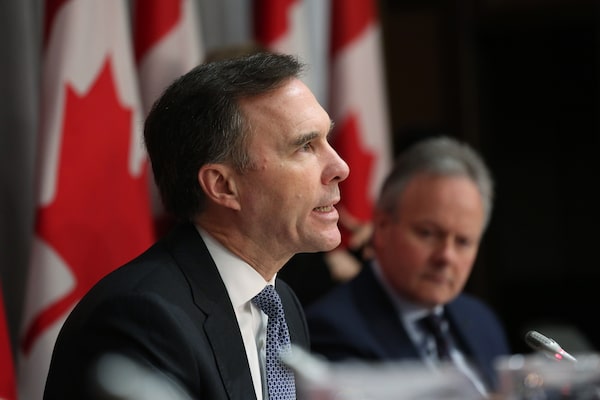
Canada's Finance Minister Bill Morneau speaks during a press conference on Parliament Hill on March 18, 2020.DAVE CHAN/AFP/Getty Images
Ottawa should continue tapping into its fiscal toolkit in the coming days to support industries and regions being disproportionately affected by the COVID-19 pandemic that is plunging the country headlong into a nasty recession, economists say.
The federal government on Wednesday announced a package that included $27-billion in direct aid, or just more than 1 per cent of gross domestic product, along with $55-billion in deferred tax payments. Finance Minister Bill Morneau said it is a “first step” and that he’s working with airlines and the energy sector on measures to help those reeling industries.
Economists credited the package as a positive step in helping households and, particularly, vulnerable workers navigate extraordinary circumstances. However, the broader economy is slowing severely – several airlines are suspending their operations, Alberta heavy crude is selling for less than US$10 a barrel, and in-bound tourism is about to stop entirely – and it’s clear that more assistance is needed and quickly.
“Certainly there’s more to be done,” said Stephen Brown, senior Canada economist at Capital Economics, adding that direct aid levels were “kind of disappointing really.”
“I think they do want to save a little bit of ammunition,” added Douglas Porter, chief economist at Bank of Montreal.
How much more could Ottawa spend? Kevin Milligan, an economics professor at the University of British Columbia, said the deficit could rise significantly in the short term, even past $100-billion, if Ottawa needs to provide further help.
“This is a World War II type event, where we take on some debt and pay it off in the next few years,” he said.
The combination of significant fiscal capacity by the federal government, and low interest rates, means that even a large amount of added debt would not pose long-term threats to Ottawa’s financial health, Prof. Milligan said.
Brian DePratto, senior economist at Toronto-Dominion Bank, said he wouldn’t be surprised to see industry-specific measures announced in the coming days.
“Restaurants are a very, very low-margin business,” he said, as an example. “A day or two of closure can be quite painful, let alone the kind of lengths we’re talking about now.”
Given the widespread nature of the disruption, every province will be affected. Alberta, Saskatchewan, Nova Scotia and Newfoundland will all see their economies contract in 2020, according to a forecast released Wednesday by TD Bank.
Jock Finlayson, executive vice-president at the Business Council of British Columbia, said B.C. will be no exception to the trend of provinces going through painful economic times.
“The word growth is no longer relevant,” he said. “The economy will be shrinking. We’re looking at a dramatic downturn. B.C. is going to join the rest of the country in a full-scale recession.”
Capital Economics projects the economy will shrink at a staggering 10-per-cent annualized rate in the second quarter as key industries take a massive hit.
“We really never see disruption on this scale and speed,” Mr. Brown said. “It’s completely unusual.”
As Ottawa rolls out its aid package and GDP declines, the federal debt-to-GDP ratio is likely to rise in the short term, the Office of the Parliamentary Budget Officer said. (The Liberals use debt-to-GDP as their fiscal anchor.)
“I don’t believe they should regard that debt-to-GDP target as being sacrosanct,” Mr. Porter at BMO said. “This is an extremely unusual situation. If the debt-to-GDP ratio has to go up for a spell, so be it.”
Wednesday’s direct support of $27-billion was tied up in various measures that will put more cash in the pockets of Canadians. This includes support for affected workers who, under normal circumstances, would not qualify for employment insurance.
The economic package also included a 10-per-cent wage subsidy for companies, aimed at helping them keep employees on payroll. Ottawa has previously announced $10-billion in additional credit available to small and medium-sized businesses facing a cash crunch.
However, the wage subsidy pales next to those being offered by Scandinavian countries, and likely doesn’t help those industries where revenue has all but stopped, and which has already led to layoffs.
“There wasn’t actually that much for companies” on Wednesday, said Mr. Brown.
With a report from Patrick Brethour and Brent Jang